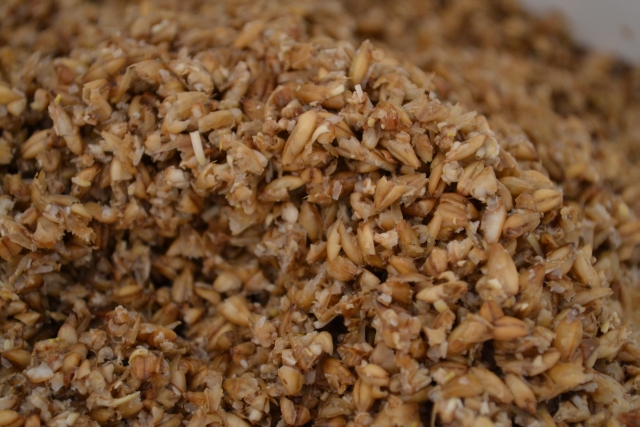Trying to figure out my low efficiency (~60% for 5 batch in a row).
A few numbers:
- 2,9 gallons batch (11 litres)
- 5,95 pounds of grain (much of them being 2 row)
- Maxium O.G. of 1.072 ( 37.5 ppg ) ** According to John Palmer **
- Actual O.G. of 1.050 ( 24 ppg )
- Strike water : 2,28 gal. (8,5L) @ 165 F -> 155 F once mixed.
- Fly Sparge water: 3,22 gal. (12L) @ 160 F (did not use all of it)
- Mash time: 60 min.
- Sparge time: at least 60 min.
Equipment: 5 gallons rubbermaid cooler, with DIY false bottom.
---
The milling of the grain is ok, according to my readings (husks are broken, but not too much to make flour)
I use tap water, and don't put anything to change the ph.
That said, I did a reading once my vorlof was done and got a gravity of 1.052. Could this be an issue? I read somewhere that this reading should be at, or close to, 1.070.
* Edit: Added the grain picture (once done) *
Update #1:
After a few comments, it seems like my issue comes from a bad mash convertion. My reading after Vorlauf should be at least at 1.080, which is hardly the case.
Reading after Vorlauf: 1.050.
Reading at the end of the fly sparge: 1.004
Reading pre-boil : 1.045.
Reading post-boil: 1.050.
Now, if I take a look at the common efficiency issue:
(found here: http://braukaiser.com/wiki/index.php?title=Troubleshooting_Brewhouse_Efficiency#Determining_Conversion_Efficiency )
Crush: The husk are crushed and some flour can be found at the bottom.
Temperature: Mash temp is 155, which end at around 153.
pH: I have no pH reader, and have no clue about it. I will buy a pH reader soon to get some readings. I add nothing to the mash for that.
Diastatic Power: More than 80% of my brews uses 2rows, which have enough Diastatic power.
Time: 60 minutes, at least.
Water/Girst Ratio: 2,61L / kg, which is what I read was the average.
Dough Balls: Maybe, but 5 times in a row? Each time I would have had differents O.G., right?
What I will do next time:
- Make sure the grain mill is set at the size of one credit card.
- Boil the water the day before to get rid of the chlorine and bad stuff.
- Do a mash out.
- Do more hydrometer readings and be more accurate (temp wise).

A few numbers:
- 2,9 gallons batch (11 litres)
- 5,95 pounds of grain (much of them being 2 row)
- Maxium O.G. of 1.072 ( 37.5 ppg ) ** According to John Palmer **
- Actual O.G. of 1.050 ( 24 ppg )
- Strike water : 2,28 gal. (8,5L) @ 165 F -> 155 F once mixed.
- Fly Sparge water: 3,22 gal. (12L) @ 160 F (did not use all of it)
- Mash time: 60 min.
- Sparge time: at least 60 min.
Equipment: 5 gallons rubbermaid cooler, with DIY false bottom.
---
The milling of the grain is ok, according to my readings (husks are broken, but not too much to make flour)
I use tap water, and don't put anything to change the ph.
That said, I did a reading once my vorlof was done and got a gravity of 1.052. Could this be an issue? I read somewhere that this reading should be at, or close to, 1.070.
* Edit: Added the grain picture (once done) *
Update #1:
After a few comments, it seems like my issue comes from a bad mash convertion. My reading after Vorlauf should be at least at 1.080, which is hardly the case.
Reading after Vorlauf: 1.050.
Reading at the end of the fly sparge: 1.004
Reading pre-boil : 1.045.
Reading post-boil: 1.050.
Now, if I take a look at the common efficiency issue:
(found here: http://braukaiser.com/wiki/index.php?title=Troubleshooting_Brewhouse_Efficiency#Determining_Conversion_Efficiency )
Crush: The husk are crushed and some flour can be found at the bottom.
Temperature: Mash temp is 155, which end at around 153.
pH: I have no pH reader, and have no clue about it. I will buy a pH reader soon to get some readings. I add nothing to the mash for that.
Diastatic Power: More than 80% of my brews uses 2rows, which have enough Diastatic power.
Time: 60 minutes, at least.
Water/Girst Ratio: 2,61L / kg, which is what I read was the average.
Dough Balls: Maybe, but 5 times in a row? Each time I would have had differents O.G., right?
What I will do next time:
- Make sure the grain mill is set at the size of one credit card.
- Boil the water the day before to get rid of the chlorine and bad stuff.
- Do a mash out.
- Do more hydrometer readings and be more accurate (temp wise).



